Alsace Itinerary & Travel Guide: Best Wineries to Visit & Hotels to Stay at During Your Trip
Three hundred miles east of Paris, at the foothills of the Vosges Mountains and near the border of Germany, lies a wine region with fairy-tale charm unlike any other: Alsace. A drive through hundreds of small villages along the Alsatian wine route with their half-timbered buildings adorned with colorful flower boxes, pastel-painted homes, fountains, steeples and vineyards and will evoke many a Brothers Grimm fable.
Although distinctly French today, the cultural differences of Alsace as compared to other French wine regions, are noted immediately from the architecture through the cuisine. Both of which will delight any Winetraveler. You see, although today a part of France, Alsace has a long and storied history of also having belonged to Germany at times. In fact, between the Thirty Years’ War and World War II, the region changed hands between the two countries numerous times.
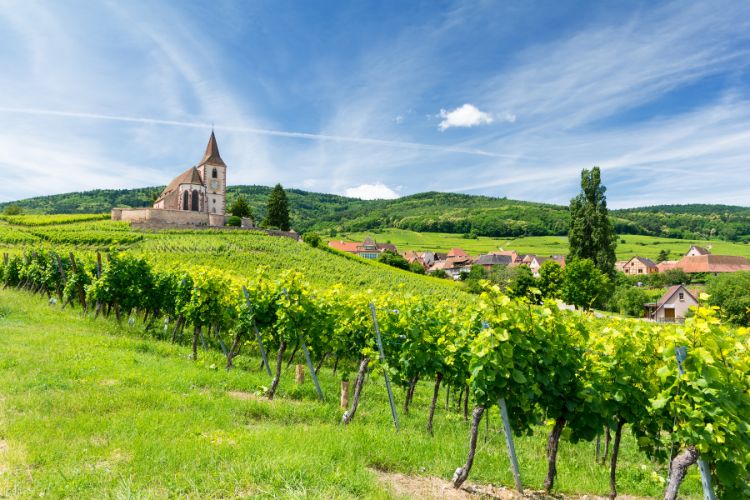
Getting To Alsace
Navigating Alsace is best done by car. The route suggested below is roughly 40 minutes from the first winery to the last, but you’ll want to set appointments, take your time and explore the many charming Old World villages along the way.
Numerous flights are available worldwide to Paris, France or Frankfurt, Germany where you can easily transfer via train or flight to Strasbourg, France which sits at the northern end of Alsace. Take a cab or hire a private driver to pick you up from the airport or train station.
From Strasbourg, rent a car and begin your meandering. Private drivers and guided day trips are also available to nearby villages, wineries and the countryside. We include additional guided and private day wine tour and day trip options below.
RELATED: The Best Alsace Wine Tours & Tasting Experiences to Book This Year
Where To Stay in Alsace
As for where to stay in Alsace, there is no shortage of quaint inns and accommodations along the wine route. Strasbourg is a bustling university and diplomat town with Alsatian charm throughout its squares, river walks and neighborhoods, and offers a variety of accommodations for all types of travelers and budgets. Colmar, one of the region’s most enchanting cities sits at the southern end of this particular itinerary and is sure to make for a delightful home base.
In Strasbourg, our top choice for a hotel is Hôtel Cour du Corbeau if you’re looking for an ideal central location in the Krutenau neighborhood. Aside from the 5-star luxury and service you can expect at this hotel, it provides the perfect home base to explore the city and the surrounding Alsation countryside.
If you choose to follow the general progression of this Alsace itinerary, you’ll end up in Colmar. Our favorite hotel in this romantic city is L’Esquisse Hotel & Spa, for its fantastic bar, location, comfy bed, unique indoor pool and opulent modern digs. If you’d prefer something that looks and feels more classically Alsatian, yet still provides 5-star luxury, stay in the center of Colmar at La Maison des Têtes.
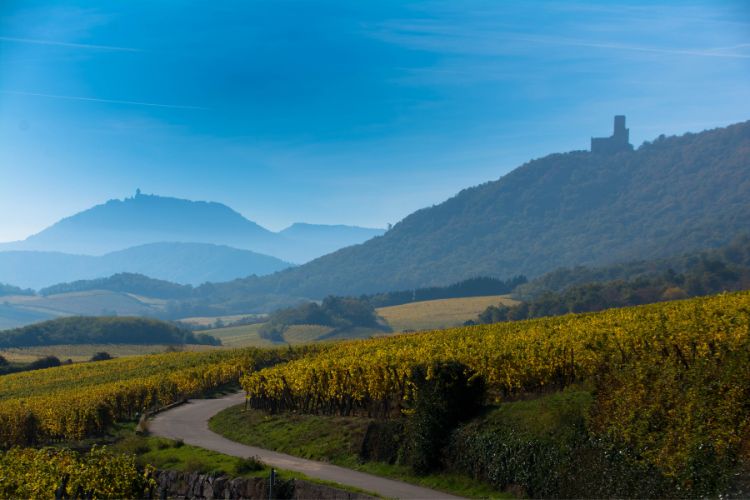
Best Alsace Wineries to Visit
With a vast number of wineries in the Alsace region, this Winetraveler itinerary focuses specifically on five of the oldest and most benchmark wineries in Alsace with histories dating back to the 15th century. Appointments are recommended, as is allowing for several hours for a winery visit. Alternatively, seek out wines at local restaurants, shops or markets from these recommended wineries as you spend time immersing yourself in the small villages of the region.
Maison Lucien Albrecht
28 Rue du Printemps, 68500 Orschwihr, France
Historical documents indicate winemaking began for the Albrecht family with Romanus Albrecht in 1425. Maison Lucien Albrecht was later established in 1698 and is one of the three founding fathers of the Crémant d’Alsace AOC. Nine generations, with Jean Albrecht at the head, continue to work the soils of the family’s vineyards including several Grand Cru AOCs, mainly situated in Orschwihr — a wine-growing village in Southern Alsace.
Domaine Zind-Humbrecht
2 Route de Colmar, 68230 Turckheim, France
Domaine Zind-Humbrecht is a winemaking tradition for the Humbrecht family that has been passed down from father to son since 1620. Today the Domaine is run by Olivier Humbrecht, the first Frenchman to attain Master of Wine status. The Domaine consists of nearly 100 acres of vines and over six communes, including four Grands Crus. After centuries of experience with the Alsatian terroir, the growers assign different Alsatian grape varieties to each of the specific soils and microclimates, respecting the specificity of each Cru. The winery is certified in both organic and biodynamic practices.
RELATED: 30 Wineries You Must Visit in Bordeaux France
Jean-Baptiste Adam
5 Rue de l’Aigle, 68770 Ammerschwihr, France
The Jean-Baptiste Adam family has grown grapes and made wines since 1614, making this one of the rare family estates which can claim more than 400 years of history. The winery today is led by 14th generation winemaker Jean-Baptiste Adam V and his daughter, the 15th generation, Laure Adam. Jean-Baptiste is responsible for transitioning the vineyards to organic and biodynamic farming, including the Grand Cru Kaefferkopf.
Domaine Paul Blanck
29 Grand-Rue, 68240 Kaysersberg, France
In 1610, Hans Blanck acquired his first vines in the Alsace region. Today Domaine Paul Blanck is led by cousins Frédéric and Philippe Blanck. The estate spans 86 acres and includes five Grands Crus and four lieux-dits which are highly regarded for the region. Located in the village of Kientzheim, Domaine Paul Blanck produces wines that are terroir-expressive without the use of chemicals.
Maison Trimbach
15 Route de Bergheim, 68150 Ribeauvillé, France
The wine-growing history of Maison Trimbach extends back to 1626. Since then, twelve generations of father and son winemakers have developed a solid reputation for excellence. Trimbach wine received international acclaim in 1898 when Frédéric Emile Trimbach received the highest distinction at the International Wine Fair in Brussels. Today, the family vineyard is run by Hubert Trimbach, his nephews Jean and Pierre, and Pierre’s daughter Anne, the eldest of the 13th generation. The 40 hectares that make up the Trimbach estate stretch over 50 parcels and six villages, including Bergheim, Ribeauvillé and Hunawihr with the crown jewel being the Clos Sainte Hune vineyard.
Winetraveler Tip: While a common misperception exists that all Rieslings are sweet, Alsatian Rieslings are typically dry with the noted exceptions of Vendanges Tardives (late harvest wines made only from the designated four noble grapes – Riesling, Gewurztraminer, Pinot Gris and Muscat) and Sélection de Grains Nobles (derived only from the noble grapes and in favorable years, these late harvest wines will be affected by noble rot). We recommend being adventurous and exploring all the wine styles of Alsace to truly understand the uniqueness of this outstanding wine region.
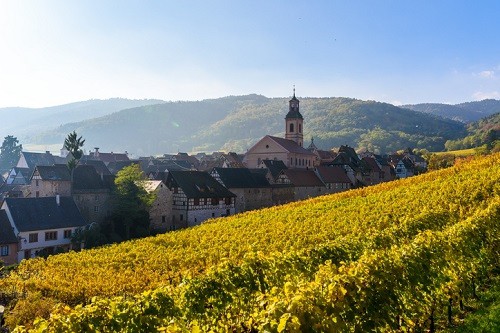
Schedule an Alsace Wine Tour
If you’re hesitant about managing the logistics of visiting wineries on the Alsace wine route yourself, consider hiring a private guide and driver for the day. Or, experience Alsace by bike. Below, we list some of our preferred tour operators, experiences and ideas for exploring Alsace in a more guided fashion.
Venture out from Colmar and enjoyed a half-day, guided experience with local guides Anna and Eric of Alsace Safari while you visit historic castles and wineries across the region.
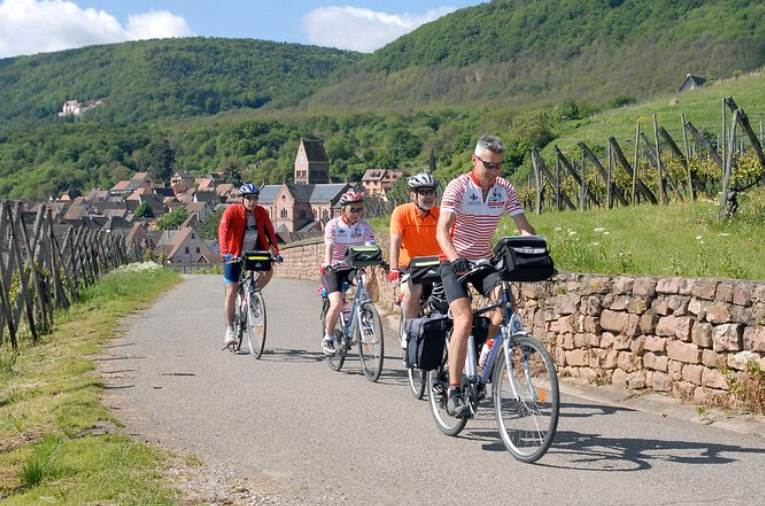
Get active and outside and see Alsace by bike, while wine tasting along the way if you choose. Bicyclette Go Tours led by Glenn Ford is the most ideal for this sort of experience in the region, as he and his team have been organizing cycling tours of Alsace since 1994. These itineraries and routes have been tried and tested for decades, and customers continue to rave about the experiences they’ve had in Alsace by bike. This is an award-winning, private day trip you don’t want to miss.
Skip the small group tour and opt for something private with a focus on the villages of Alsace plus wine tastings. JoliSoleil runs a fantastic day tour of Alsace with customizable options that leaves from Strasbourg.
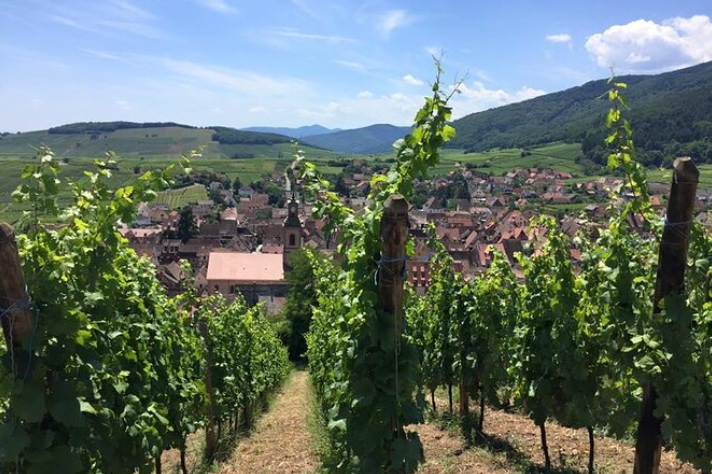
Embark on an intimate tour from Colmar with Alsace Original Experiences and enjoy the advantage of a small group setting as you traverse the Alsatian Wine Route. The journey includes stops at a local wine cave for tasting delectable Alsace wines and an exploration of the ‘4 Wonders of Alsace’ – the charming villages of Eguisheim, Kayserberg, Ribeauvillé, and Riquewihr.
Capture stunning snapshots as you journey along the picturesque Alsace Wine Route. Get a taste of the region’s famed wines, such as Gewurztraminer, Pinot Gris, and Pinot Blanc. Travel in comfort, to and from Colmar, in an air-conditioned minivan, making your experience all the more enjoyable.
This small-group tour ensures a personalized experience, with a maximum of just eight participants.
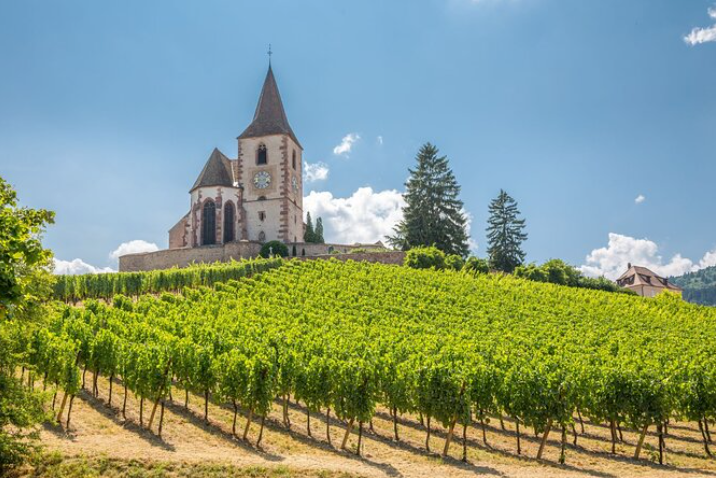
From Strasbourg, traverse the iconic Alsace Wine Route with Ophorus Tours and discover enchanting villages such as Dambach-la-Ville, Ribeauvillé, Mittelbergheim, and Riquewihr. Experience three unique wineries, sampling some of Alsace’s renowned wines including the delightful Gewürztraminer and Riesling.
Benefit from the expert knowledge of your guide as you delve into the region’s history and viticulture. Enjoy an intimate and personalized tour experience, with a small group setting limited to just eight participants.
This full-day journey through Alsace allows you to appreciate the region’s scenic beauty, taste exceptional wines, and explore the quaint villages of Mittelbergheim, Dambach-la-Ville, Ribeauvillé, and Riquewihr, making for a truly immersive experience. Ophorus also offers a similar tour option that leaves from Colmar.
The Wines of Alsace
Despite the political turmoil of the region over the centuries, winemaking in Alsace has remained a constant with many winemaking families dating back nearly 20 generations. These families were, and remain to this day, driven by two principle factors: grapes and ground. The long-held philosophy of winemakers in Alsace has been to produce wines showcasing the pure flavors and qualities of the grapes and the uniquely diverse soils from which they are cultivated.
The Alsace region is protected by the Vosges Mountains, which keep both rain and clouds at bay and are responsible for the sunny summers and dry autumns, and thus present the ideal conditions in which grapes can fully ripen. What’s more, the incredibly diverse soil types found throughout Alsace — which range from chalk, clay, limestone, granite, sandstone and schist to volcanic rock — allows viticulturists to match each grape variety to the soils for which they’re best suited. This enables a range of wine styles to be produced. From light-bodied and fresh to full-bodied and bold.
More than 38,000 acres of vineyards planted in Alsace run North to South with the best quality vineyards sitting on the steep slopes with East and Southeast facing aspects. With nearly 4,000 winegrowers, the predominant style produced is aromatic white wines from a handful of grape varieties including Riesling, Gewurztraminer, Pinot Gris, Muscat and Pinot Blanc.
Chardonnay is also produced but only for Crémant d’Alsace sparkling wines as it is not permitted to be produced as a still wine varietal in Alsace. A small percentage of red wines are also made exclusively from Pinot Noir.
This small wine region has an astounding 53 AOCs including AOC Alsace, AOC Crémant d’Alsace (traditional method sparkling wine) and 51 individual Grand Cru AOCs. Fortunately for the wine consumer, wines here are labeled by grape variety rather than AOC, a unique labeling feature in France.
Winetraveler Tip: Alsace white wines age remarkably well and are not to be missed!
Frequently Asked Questions about Alsace Wineries & Wine Tours
You are reading “Best Alsace Wineries & Alsace Wine Tours: Perfect Itinerary” Back To Top
wineries near me, wine tasting in Alsace France, Alsace wineries, wine tours: top destinations in France to visit this year
If you enjoyed this guide, make sure you register to become a Winetraveler for free! You’ll get access to all of our content and interact with other Winetravelers and for travel inspiration around the world. Be sure to follow along with us on Twitter and Instagram as we continue to feature more exciting destinations.
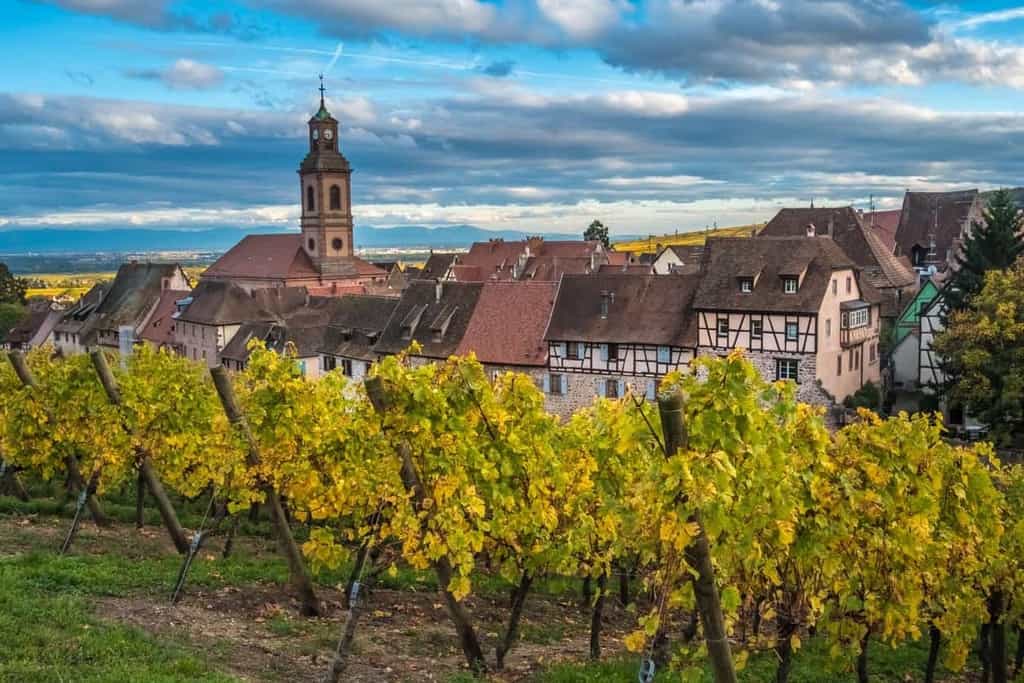
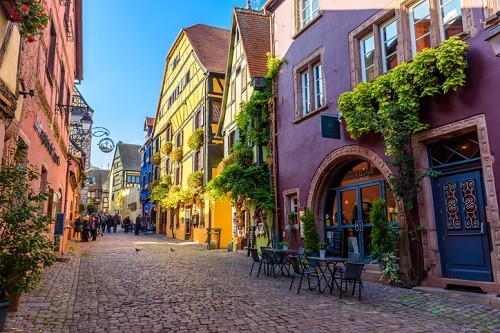
[…] The Alsace Wine Route is 170 km long, starting near Strasbourg in the north and ending just south of Colmar. As mentioned earlier this area is a wonderful blend of French and German culture. Colourful, half-timbered buildings line cobblestoned streets with wine merchants and paddocks of vines around every corner. The wine route takes in some legendary towns such as Ribeauville, Kayserberg and Eguisheim. […]